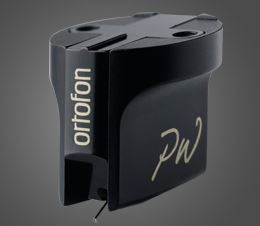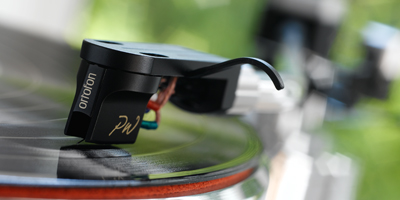The Ortofon Per Windfeld phono cartridge was developed in 2008 as a tribute to retired engineer Per Windfeld who worked for Ortofon for more than 30 years. He was instrumental in the development of the MC 20 Super and Rohmann cartridges, and also the Kontrapunkt and Jubilee cartridges which were previously reviewed here on 10 Audio.

The $3,900 Per Windfeld has a specified output voltage of 0.3mV, excellent channel balance of <0.2 db, channel separation of 28 dB at 1 khz, frequency range 10-80 kHz, and dc resistance of 4 Ohms. As in the Ortofon Jubilee, the cantilever is made of boron and the coils are wired with gold-plated 99.999999% oxygen-free monocrystalline copper. The resonance-reducing sculptured body is made from a stainless steel alloy and weighs 13 gram. The short, threaded mounting holes require screws of the correct length. A good assortment of hardware is provided for compatibility with headshells of any thickness. Innovations includes a patented damping system, Replicant 100 diamond stylus which features a large vertical contact area, and neodymium magnet with field stabilizing element, Please see the Ortofon Web site for further information about these innovations.
Other components on hand during the audition included a Basis 2500 Signature turntable with Vector 4 and MØRCH DP-8 tonearms, Miyajima Kansui and Benz LP-S moving coil cartridges, Whest PS.30RDT Special Edition phono preamplifier, RCM Sensor Prelude IC phono preamplifier, Bob’s Devices CineMag 1131 “Blue” step-up transformer, Mark Levinson 326S preamplifier with phono, Prism Orpheus Digital Interface with custom Windows 7 computer/music server, YG Acoustics Kipod II Signature Main Modules speakers, Dali Mentor 5 speakers (from the home theater system), and Gallo TR-3 subwoofers. Power amplifiers included Manley Snappers and Spread Spectrum Technologies Ampzilla 2000 2nd Edition. Interconnects and speaker cables are mostly Mogami. The Firewire cable joining the music server and Prism Orpheus is Audioquest Carbon. All front end components receive their AC power from a PS Audio AV-5000 power conditioner which is connected to the wall power with a Shunyata Anaconda CX power cord. A PS Audio Quintet, connected to the utility grid with another slithering Anaconda CX, is normally used for the power amplifiers. Other Shunyata CX series power cords are used elsewhere in the system, and Jerry’s DIY power cords can be found on the music computer and Levinson preamp. The entire system is turned on and off from the Levinson’s remote control.
The bass and upper bass are excellent, having both realistic power and extension into the lowest bass. There is unusually precise imaging, although the soundstage never extends outside the positions of the loudspeakers. The sound stage has excellent lateral placement of performers with clearly defined images of individual performers. The depth of the perceived sound stage is adequate which somewhat limits a complex orchestral stage of accurate placement of instruments towards the rear of the stage. Of course, this is never a concern for music which is constructed in a studio.
Ortofon recommends loading at greater than 10 Ohms. Using my standard “multiply the DC resistance by 20” starting point for loading, I quickly found that 100 Ohms resulted in a dull and lifeless presentation. Even 475 Ohms robs the presentation of upper frequency resolution and balance with the upper midrange. I settled on 1k Ohms as the best overall compromise for good treble resolution without harshness or glare. I tried different load settings extensively with both phono preamplifiers but was not able to obtain a consistent harmonic character between the rich and believable midrange and a sharper and thinner lower treble without reducing resolution and sparkle in the mid- to upper-treble. This was an attractive sound for electric guitar, but made acoustic guitar sound artificial and similar to CD sound. As a partially balancing character trait, the low level resolution is outstanding and is well appreciated as an instrument’s harmonic trail fades into silence.
The Per Windfeld offers a clear and dynamic presentation. The large scale (macro) dynamic performance is excellent, and the resolution of very low-level details is also excellent. There is very satisfying power in the sounds of drums, a plucked string, or a tap of a cymbal. Each impact is clearly evident and believable. This sense of power and scale is the main strength of the Per Windfeld cartridge.

Sibilants can be unnaturally sharp and prominent and the overall presentation focuses on the upper midrange. This could be partially attributed to the loading at 1k Ohm, but dropping much below that value removes the life and vitality from the treble by reducing resolution. I attempted to use a new rule for loading: use the highest value without brightness or glare. From 100 Ohms to 10k Ohms loading, a consistent harmonic balance between octaves was elusive. This apparent tonal aberration was also noted, but to a lesser extent, with the cartridge connected through the CineMag step-up transformers, and the phono preamplifiers set for 47k Ohm loading. The recommended tracking force of about 2.6 grams offered excellent tracking.
Phono cartridge reviews must always be taken in the context of the review system. This is because you never listen to a phono cartridge separately as a unique component. The cartridge’s interaction with the tonearm and turntable, and also the phono preamplifier, can change the sound of the cartridge significantly. In the same environment provided for the Per Windfeld cartridge, I found the Miyajima Kansui to be perfectly tonally and harmonically consistent from the lower midrange to the upper treble. This character of the Miyajima cartridge has been evident with all gear reviewed for over two years. The Kansui also presents a deeper sound stage. The Benz LP-S is much sweeter and a bit less resolved in the treble than the Ortofon cartridge, although the Benz’s overall tonal and harmonic balance is similar to the Kansui and consistent across the audio frequency range.
Given the excellent sound obtained from the Jubilee, I am surprised at the results of this evaluation. Of course, the entire record playing system is different from that used with the Jubilee back in 2006. Assuming the Per Windfeld performs at a higher level than the Jubilee, one might conclude that a more accommodating turntable and tonearm, and possibly a step-up transformer, should be used to realize this increase in performance. The rating below has not been adjusted for these assumptions, which, unfortunately, make easy comparisons to the Jubilee practically impossible. It simply reflects how the cartridge actually performed in the system above.
Overall Rating: 7.5 LPs
Link to manufacturer: Ortofon
